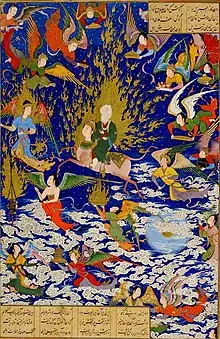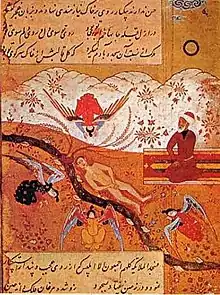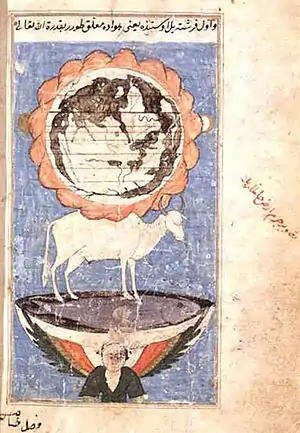Islamic mythology
Islamic mythology is the body of myths associated with Islam and the Quran. Islam is a religion that is more concerned with social order and law than with religious ritual or myths.[1] The Oxford Companion to World Mythology identifies a number of traditional narratives as "Islamic myths".[1] These include a creation myth and a vision of afterlife, which Islam shares with the other Abrahamic religions, as well as the distinctively Islamic story of the Kaaba.[1]
| Part of a series on |
| Islam |
|---|
 |
|


The traditional biography of the Islamic prophet Muhammad, which plays a central role in Islamic teachings, is generally recognized as being largely historical in nature, and Islam depends less on mythology than Judaism and Christianity.[1] However, the canonical narrative includes two key supernatural events: the divine revelation of the Quran and the Isra and Mi'raj — the night journey to Jerusalem followed by the ascension to the Seventh Heaven.[1] In addition, Islamic scriptures contain a number of legendary narratives about biblical characters, which diverge from Jewish and Christian traditions in some details.[1]
Religion and mythology
The discussion of religion in terms of mythology is a controversial topic.[2] The word "myth" is commonly used with connotations of falsehood,[3] reflecting a legacy of the derogatory early Christian usage of the Greek word muthos in the sense of "fable, fiction, lie" to refer to classical mythology.[4] However, the word is also used with other meanings in academic discourse. It may refer to "a story that serves to define the fundamental worldview of a culture"[3] or to stories which a given culture regards as true (as opposed to fables, which it recognizes as fictitious).[5]
Biblical stories in the Quran
The Quran includes many biblical narratives. Central figures, such as Moses (Musa),[6] Abraham (Ibrahim),[7] Joseph (Yūsuf), Mary (Maryam)[8] and Jesus (Isa), reappear throughout the Quran. However, in contrast to the Biblical narratives, the Quran only provides a summary of a certain story, and gets into the religio-moral point, rather scattered through the Quran, instead offering such narrations in a chronological order. More extensive details about stories incorporated by the Quran were taken from extra-Islamic sources (Isra'iliyyat). Alluding that such stories were of Jewish origin, in fact, Isra'iliyyats may also derive from other religions, such as Christianity or Zoroastrianism.[9] Many of them were stored in Qisas Al-Anbiya (Tales of Prophets), but also integrated in Quranic exegesis (Tafsir). Although important in early Tafsir, later scholars discouraged the usage of Isra'iliyyats.[10] Besides narrations from the canonical Bible, Islam further adapted Apocryphal and Midrashic writings.[11]
Creation narrative
Creation of the world
In the Quran, the heavens and the earth were joined together as one "unit of creation", after which they were "cloven asunder".[12][13] After the parting of both, they simultaneously came into their present shape after going through a phase when they were smoke-like.[14][13] The Quran states that the process of creation took 6 youm(يوم),[15][13] In the Quran, the word youm (often translated to "era") and means day.
According to the mufassirs, Islam acknowledges three different types of creation:
- Ex-nihilo in time: A position especially held by most classical scholars: God existed alone in eternity, until God's command "Be", thereupon the world came into existence. This world is absolute distinct from God. Accordingly, the world was neither created out of His own essence nor did God create the world out of a primordial matter which preceded the creation, but created by His sheer command not bound on the laws of nature.[16]
- Emanation: Found especially among scholars such as Al-Farabi and Ibn Sina: Accordingly, the world was created out of nothing, but not in time. The world was eternal, but temporary in essence.[17]
- Creation out of primordial matter: Maintained by scholars such as Ibn Taimiyya: God fashioned the whole world out of primordial matters, the waters and the smoke.[18]
Creation of humanity
According to Quranic creation narrative, God informed the angels, that He was going to create a khalifa (vicegerent) on earth. The meaning of Khalifa hold different interpretations within Islamic exegesis:
- Successor: Adam and his descendants replace another species, who formerly inhabited and ruled the earth. Accordingly, the jinn preceded humanity, but God decided to replace them, due to their malevolence. Whereupon God sent an army of angels to annihilate the rule of jinn. Iblis, the future devil, plays a significant role in this story, either as the angel, who led his army into battle against the jinn, whereafter he declined to acknowledge the dignity of their successors, or as one of the few pious jinn, which were spared by the angels, but became an infidel, by opposing his successor.[19][20][21]
- Deputy: Adam and his descendants are thought of as the deputy of God. Therefore, humans are obligated to maintain the earth given by God and should spiritualize God's attributes, to rule and govern it in accordance with God's will.[22][23] The heavenly Adam, who has learned the names of God, functions as the prototype of Al-Insān al-Kāmil (Perfect human), which the still flawfull have to become.
Adam is according to Islam, both the first human and the first prophet.[24] The Quran says that he and his wife dwelled in Garden of Eden. The Quranic counterpart of the fall of man differs in some regards from the Book of Genesis. The Quran does not blame women for seducing men, since both Adam and his in the Quran unnamed wife, eat from the forbidden tree. Further, the forbidden tree is not identified as Tree of the knowledge of good and evil but as Tree of Eternity. The Quran does not mention the serpent as a symbol for the devil, but only Satan himself. While the Old Testament curses the earth for Adams transgression, according to the Quran, God declares the earth as a dwelling place for humans, but not curses it nor is Adam destined to die for his sin,[25] thus lacking the doctrine of original sin, prevailing in Christian theology. Islamic theology gives a more optimistic attitude towards humanity's fall. Only due to free will, humans are able to produce good. Thus, although Adam's disobedience created evil, only this made it possible to create good[26] The disobediences of Adam and his wife were already forgiven by God during their life.[27][28]
Islamic traditions are more extensive, adding further details into the Quranic creation narrative. According to a common narrative, God ordered the Archangels to collect a handful of soil from earth. But every time an archangel approached earth, the earth sought refuge in God, that it might not be distorted. All the archangels returned empty-handed, except Azrael, who succeeded because he sought refuge in God before, for that he will not returned unsuccessful.[29] Another common traditions, portrayed the body of Adam lying on the ground for forty years, whereupon Iblis became curious of the new creation. After investigating the lifeless body, he promised that, if he will gain authority over it, he will destroy it.[30] In another tradition, it is not Azrael, but Iblis, included among the archangels, who succeeded in collecting soil from the earth, thus he later declined to prostrate himself before whose formation he just assisted.[31]
Islamic traditions often use figures similar to the Biblical narrative. Adam's wife is commonly named Hawa, and the serpent reappears together with a peacock as two animals, which supported Iblis to slip into Adam's abode.[32] Many denied, that the Garden in which Adam dwelled with his wife, was identical with the Paradise in afterlife. They rather lived in paradisical conditions before their fall, while after their fall, they need to work to survive. Unlike Christian mythology, in Islamic thought, they did not simply walk out of paradise, but fell out of it. Hawa was punished with childbirth, menstruation and stupidity, while Adam became bald[25] and the serpent lost its legs.
Regarding the creation of Muhammad, Islam developed the belief in the pre-existence of Muhammad.[lower-alpha 1] This posits that God created the spiritual nature of Muhammad before God created the universe or Adam.[34] Following this belief, Muhammad was the first prophet created, but the last one sent to mankind.[33] When Adam walked in heaven, he once read the Shahada inscripted in the Throne of God, a belief attested by Al-Bayhaqi, who attributes it to Umar.[35] In a Shia version, the inscription also mentions Ali.[36]
Spiritual creatures
In the Quran, fire (nar) makes up the basic substance for spiritual entities,[37] in contrast to humans created from clay (tin). Islamic traditions state more precisely, how different spiritual creatures were created. Islamic mythology commonly acknowledges three different types of spiritual entities:[37]


- Angels, created from light (nur) or fire (nar):[38] the heavenly hosts, and servants of God. Eminent among them are the four Archangels (Jibra'il, Mika'il, Azra'il and Israfil), Kiraman Katibin, who record a person's good and bad deeds, Maalik, who guards the Hellfire, Munkar and Nakir, two angels questioning the dead and Harut and Marut, two angels instructed to test mankind by teaching of knowledge of magic.
- Jinn, created from a mixture of fire and air or smokeless fire (marigin min nar):[39][40] morally ambivalent creatures, can convert to Islam and are subject to salvation or damnation. Jann is usually perceived as an ancestor of the jinn.
- Shayatin, created from smoke or fire (Samūm):[41] comparable to Christian demons or devils, usually regarded as the offspring of Iblis, who is the head of shayatin. They tempt humans (and jinn) into sin. In Islamic folklore, Ifrit and Marid are usually two powerful classes of shayatin.
Other prominent creatures within Islamic mythological traditions are Buraq, Houris and Yajuj and Majuj (Gog and Magog). Later, spiritual entities from other cultures were identified with whose of the Quran and assimilated to Islamic lore, such as Peri of Persian-[42] Ghoul of Arabian- and İye[43] of Turkic origin.
Places

According to popular ideas derived from cultural beliefs during the Classical Islam period, the earth is flat, surrounded by water, which is veiled in darkness, with Mount Qaf at the edge of the visible world. The world is carried by different creatures: an angel, a bull and a fish. Zakariya al-Qazwini identified the bull and the fish with the biblical monsters, Behemoth and Leviathan.[44] Both heaven and hell coexist with the temporary world. The seven layers of hell are identified with the seven earths. Sijjin is one of the lowest layers of hell, while Illiyin the highest layer of heaven.[45] Hell is portrayed with the imageries of seas of fire, dungeons, thorny shrubs, the tree of Zaqqum, but also immense cold at bottom, inhabited by scorpions, serpents, zabaniyya and shayatin.[46] The imageries heavens are described with different colors, seas of light, the tree of heaven, inhabited by angels and houris,[47] as a Garden with sprawling meadows and flowing rivers. The inhabitants can rest on couches bedecked with silk and visit the other deads if they wish.[48]
Islamic scholars knew the world was not flat. Islamic astronomy was developed on the basis of a spherical earth inherited from Hellenistic astronomy.[49] The Islamic theoretical framework largely relied on the fundamental contributions of Aristotle (De caelo) and Ptolemy (Almagest), both of whom worked from the premise that the Earth was spherical and at the centre of the universe (geocentric model).[49]\
The 11th-century scholar Ibn Hazm stated: "Evidence shows that the Earth is a sphere but public people say the opposite." He added: "None of those who deserve being Imams for Muslims has denied that Earth is round. And we have not received anything indicates a denial, not even a single word."[50]
The Kaaba
According to Islamic mythology, God instructed Adam to construct a building (called the Kaaba) to be the earthly counterpart of the House of Heaven and that Ibrahim (Abraham) and Ismail (Ishmael) later rebuilt it on its original foundations after was destroyed in the flood of Nuh (Noah).[51][52] According to other opinions, Ibrahim and Ismail were the first to build it.[52] As Ismail was searching for a stone to mark a corner with, he met with the angel Jibrail (Gabriel). Jibrail gave him the Black Stone. According to the hadith,[53] the Black Stone is reported to have been milky white after being descended from Heaven but was rendered black due to the sins of the people, who had touched it.[54][55] Muslims do not worship the Black Stone.[56]
The Kaaba was originally intended as a symbolic house for the one monotheistic God. However, after Ibrahim's death, people started to fill the Kaaba with pagan idols. When Muhammad conquered Mecca after his exile, he removed the idols from the Kaaba.[57][58] The inside of the Kaaba is now empty.[59] It now stands as an important pilgrimage site, which all Muslims are supposed to visit at least once if they are able (Hajj).[60][59] Muslims are supposed to pray five times a day while facing in the Kaaba's direction (qibla).[59][61]
Events
- Creation - a six-stages creative act by God
- Fall of man - expulsion from Heaven
- Deluge and Noah's (Nuh's) Ark- flood-event. Unlike Christianity, the flood might be either global or local
- The Exodus - Story of Moses leaving Egypt, whereupon God reveals Tawrat to him on biblical Mount Sinai
- Qiyamah - the Day of Resurrection; a fundamental element of Islamic eschatology that incorporates much from the Jewish and Christian traditions
In Salafi thought
With the advent of Salafi reformism, starting during the Age of Enlightenment onwards, Muslim thinkers and scholars sought out for a more practical model to restore Muslim community accompanied by the threat of western colonization, downplaying the mystic, cosmic and mythological aspects attributed to Muhammad, while simultaneously emphasizing him and his sunnah's social and political role.[62]
Many adherents of the Muslim Brotherhood reject most of traditional Islamic mythological narratives. Sayyid Qutb broke the connection between Khidr and the Quran, by eliminating his identification with God's servant mentioned in Surah 18 in his tafsir. Accordingly, whose who follow him, would not longer perceive Khidr as figure related to Islamic faith.[63] The teachings of Sulaiman Ashqar disapprove many records about the traditional material regarding angels, including Classical scholars, who used them, what leads to a marginalization of Islamic thought of angels, including names and stories regarding their origin.[64]
Notes
- The idea of Pre-Islamic Muhammad in deeply rooted in Islamic tradition and already attested in the Sunni-canonical collection (al-Tirmidhi). The association of Muhammads pre-existence with light can also be found in Ibn Ishaq's Sira. Later, both Sunni and Shia sources extended this motif to construct cosmological scenarios.[33]
References
- David Leeming (2005). "Islamic Mythology". The Oxford Companion to World Mythology. Oxford University Press. pp. 207–211. ISBN 9780190288884.
- David Leeming (2005). "Preface". The Oxford Companion to World Mythology. Oxford University Press. p. vii. ISBN 9780195156690.
- Grassie, William (March 1998). "Science as Epic? Can the modern evolutionary cosmology be a mythic story for our time?". Science & Spirit. 9 (1).
The word 'myth' is popularly understood to mean idle fancy, fiction, or falsehood; but there is another meaning of the word in academic discourse. A myth, in this latter sense of the word, is a story that serves to define the fundamental worldview of a culture
- Eliade, Myth and Reality, 1968, p. 162.
- Eliade, Myth and Reality, p. 1, 8-10; The Sacred and the Profane, p. 95
- Quran 17:2
- Quran 14:35-52
- Quran 19:16-33
- Isabel Lang Intertextualität als hermeneutischer Zugang zur Auslegung des Korans: Eine Betrachtung am Beispiel der Verwendung von Israiliyyat in der Rezeption der Davidserzählung in Sure 38: 21-25 Logos Verlag Berlin GmbH, 31.12.2015 ISBN 9783832541514 p. 30 (German)
- Scott B. Noegel, Brannon M. Wheeler The A to Z of Prophets in Islam and Judaism Scarecrow Press 2010 ISBN 978-1-461-71895-6 page 158
- Isabel Lang Intertextualität als hermeneutischer Zugang zur Auslegung des Korans: Eine Betrachtung am Beispiel der Verwendung von Israiliyyat in der Rezeption der Davidserzählung in Sure 38: 21-25 Logos Verlag Berlin GmbH, 31.12.2015 ISBN 9783832541514 p. 98 (German)
- Q21:30 Quran 21:30
- "Islam Creation Story". www2.nau.edu. Retrieved 2018-09-15.
- Quran 41:11
- Quran 11:7
- Husam Muhi Eldin al- Alousi The Problem of Creation in Islamic Thought, Qur'an, Hadith, Commentaries, and KalamNational Printing and Publishing, Bagdad, 1968 p. 29 and 96
- Husam Muhi Eldin al- Alousi The Problem of Creation in Islamic Thought, Qur'an, Hadith, Commentaries, and KalamNational Printing and Publishing, Bagdad, 1968 p. 179
- Husam Muhi Eldin al- Alousi The Problem of Creation in Islamic Thought, Qur'an, Hadith, Commentaries, and KalamNational Printing and Publishing, Bagdad, 1968 p. 53
- Patricia Crone The Qurʾānic Pagans and Related Matters: Collected Studies in Three Volumes, Band 1 BRILL, 09.06.2016 ISBN 9789004319288 p. 200
- Mahmoud Ayoub The Qur'an and Its Interpreters , Volume 1 SUNY Press, 1984 ISBN 9780873957274 p. 73
- Brannon Wheeler Prophets in the Quran: An Introduction to the Quran and Muslim Exegesis A&C Black 2002 ISBN 9780826449566 Page 16
- Annemarie Schimmel Mystical Dimensions of Islam Univ of North Carolina Press, 1975 ISBN 9780807812716 p. 188
- Mahmoud Ayoub The Qur'an and Its Interpreters , Volume 1 SUNY Press, 1984 ISBN 9780873957274 p. 79
- Lalljee, compiled by Yousuf N. (1981). Know your Islam (3rd ed.). New York: Taknike Tarsile Quran. p. 71. ISBN 978-0-940368-02-6.
- Patricia Crone Medieval Islamic Political Thought Edinburgh University Press, 11.03.2014 ISBN 9780748696505
- P. Koslowski The Origin and the Overcoming of Evil and Suffering in the World Religions Springer Science & Business Media 2013 ISBN 9789401597890 pp. 34-35
- Amina Wadud Qur'an and Woman: Rereading the Sacred Text from a Woman's Perspective Oxford University Press 1999 ISBN 9780198029434 p.25
- Quran 2:37
- Scott B. Noegel, Brannon M. Wheeler The A to Z of Prophets in Islam and Judaism Scarecrow Press 2010 ISBN 978-1-461-71895-6 page 13
- Alexander Kulik, Catherine Mary MacRobert, Svetlina Nikolova, Moshe Taube, Cynthia M. Vakareliyska The Bible in Slavic Tradition BRILL 2016 ISBN 9789004313675 p. 351
- Leigh N. B. Chipman. “Mythic Aspects of the Process of Adam's Creation in Judaism and Islam.” Studia Islamica, no. 93, 2001, pp. 5–25. JSTOR, www.jstor.org/stable/1596106.
- Amira El-Zein Islam, Arabs, and Intelligent World of the Jinn Syracuse University Press 2009 ISBN 9780815650706 page 98-99
- Marion Holmes Katz The Birth of The Prophet Muhammad: Devotional Piety in Sunni Islam Routledge 2007 ISBN 978-1-135-98394-9 page 13
- MACDONALD, JOHN. THE CREATION OF MAN AND ANGELS IN THE ESCHATOLOGICAL LITERATURE: [TRANSLATED EXCERPTS FROM AN UNPUBLISHED COLLECTION OF TRADITIONS]. Islamic Studies, vol. 3, no. 3, 1964, pp. 285–308. JSTOR, www.jstor.org/stable/20832755.
- Uri Rubin, “Pre-Existence and Light—Aspects of the Concept of Nūr Muḥammad”, Israel Oriental Studies 5 (1975), 62–119 [Reprinted in: Uri Rubin, Muhammad the Prophet and Arabia , Variorum Collected Studies Series (Ashgate, 2011) p. 106
- M.J. KISTER ADAM: A STUDY OF SOME LEGENDS IN TAFSIR AND HADIT LITERATURE Approaches to the History 0f the Interpretation of The Qur'an, Oxford 1988 p.129
- Tobias Nünlist Dämonenglaube im Islam Walter de Gruyter GmbH & Co KG, 2015 ISBN 978-3-110-33168-4 p. 47 (German)
- Jane Dammen McAuliffe Encyclopaedia of the Qurʼān: vol. 5 Brill, 2005 ISBN 9789004123564 p. 118
- Jane Dammen McAuliffe Encyclopaedia of the Qurʼān: vol. 3 Brill, 2005 ISBN 9789004123564 p. 48
- Beatrice Gruendler, Michael Cooperson Classical Arabic Humanities in Their Own Terms: Festschrift for Wolfhart Heinrichs on His 65th Birthday BRILL, 2008 ISBN 9789004165731 p. 104
- Tobias Nünlist Dämonenglaube im Islam Walter de Gruyter GmbH & Co KG, 2015 ISBN 978-3-110-33168-4 p. 49 (German)
- Frederick M. Smith The Self Possessed: Deity and Spirit Possession in South Asian Literature and Civilization Columbia University Press 2012 ISBN 978-0-231-51065-3 page 570
- Fuzuli Bayat Türk Mitolojik Sistemi 2: Kutsal Dişi – Mitolojik Ana, Umay Paradigmasında İlkel Mitolojik Kategoriler – İyeler ve Demonoloji Ötüken Neşriyat A.Ş 2016 ISBN 9786051554075 (Turkish)
- M. Th. Houtsma E. J. Brill's First Encyclopaedia of Islam, 1913-1936, Band 4 BRILL, 1993 ISBN 9789004097902 p. 615
- Christian Lange Locating Hell in Islamic Traditions BRILL 978-90-04-30121-4 p. 12
- Christian Lange Locating Hell in Islamic Traditions BRILL 978-90-04-30121-4 p. 14
- Abu Ashaq Ahmad At-Talabi, Aḥmad ibn Muḥammad Thaʻlabī Islamische Erzählungen von Propheten und Gottesmännern: Qiṣaṣ al-anbiyāʼ oder ʻArāʼis al-maǧālis Otto Harrassowitz Verlag, 2006 ISBN 9783447052665 pp. 20-22
- Christian Lange Paradise and Hell in Islamic Traditions Cambridge University Press, 2015 ISBN 978-0-521-50637-3 pp. 125, 132
- Ragep, F. Jamil: "Astronomy", in: Krämer, Gudrun (ed.) et al.: Encyclopaedia of Islam, THREE, Brill 2010, without page numbers
- Ash-Shareef, Abdurrahim Khairullah Omar (2014). "Aspects of Ancient Muslim Scholars' Induction Drawn from the Holy Qur'an in Proving Earth is Spherical". Zarqa University: 217. Cite journal requires
|journal=(help) - M. J. Akbar (2002). The Shade of Swords: Jihad and the Conflict Between Islam and Christianity. p. 5. ISBN 9780415284707.
- "Kaaba - Oxford Islamic Studies Online". www.oxfordislamicstudies.com. Retrieved 2018-09-15.
Cube-shaped “House of God” located in Mecca, Saudi Arabia. Focal point of the hajj pilgrimage and a world spiritual center that all Muslims face during prayer. Muslims believe that it was built by Abraham (Ibrahim) and Ishmael (Ismail); some believe Adam built it and Abraham and Ishmael only rebuilt it. Often called the earthly counterpart to God's throne in heaven. Circumambulated seven times during the hajj ritual in imitation of angels circumambulating God's throne. Contains the Black Stone, which pilgrims often try to touch or kiss during circumambulations, believing that it physically absorbs sin; all pilgrims salute the stone as a gesture of their renewed covenant with God. Covered with a cloth called kiswah, which is embroidered with verses from the Quran.
- Jami` at-Tirmidhi, hadith #877 / Book 9, Hadith 70 / Vol. 2, Book 4, Hadith 877
- "Black Stone of Mecca | Islam". Encyclopedia Britannica. Retrieved 2018-09-15.
- Elsebeth, Thompson (1980). "New Light on the Origin of the Holy Black Stone of the Ka'ba". Meteoritics. 15 (1): 87–91. Bibcode:1980Metic..15...87T. doi:10.1111/j.1945-5100.1980.tb00176.x.
- Hedin, Christer. "Muslim Pilgrimage as Education by Experience": 176. CiteSeerX 10.1.1.1017.315. Cite journal requires
|journal=(help) - "Cmje". Archived from the original on 2009-02-01.
- "Bridging Cultures Bookshelf: Muslim Journeys". bridgingcultures.neh.gov. Retrieved 2018-09-15.
- "Important Sites: The Kaba". Inside Islam. 2012-02-14. Retrieved 2018-09-15.
- "Hajj - Oxford Islamic Studies Online". www.oxfordislamicstudies.com. Retrieved 2018-09-15.
- "qibla | Art History Glossary". blog.stephens.edu. Retrieved 2018-09-15.
- Daniel W. Brown Rethinking Tradition in Modern Islamic Thought Cambridge University Press ISBN 9780521653947 p. 65
- Quintan Wiktorowicz Quintan Wiktorowicz Pages 207-239 | Received 10 Jan 2005, Accepted 12 Apr 2005, Published online: 19 Aug 2006
- Stephen Burge Angels in Islam: Jalal al-Din al-Suyuti's al-Haba'ik fi Akhbar al-malik Routledge 2015 ISBN 978-1-136-50473-0 p. 13-14
Sources
- Huston Smith. The Religions of Man. NY: Harper & Row (Perennial Library), 1965.
- Robert A. Segal. Myth: A Very Short Introduction. NY: Oxford UP, 2004.
- Zong In-Sob. Folk Tales From Korea, Third Edition. Elizabeth: Hollym International, 1982.
- Mircea Eliade. Myth and Reality. Trans. Willard R. Trask. NY: Harper & Row (Harper Torchbooks), 1968.
- The Holy Quran. Electronic Text Center, University of Virginia Library. Available online.
External links
![]() Media related to Islamic mythology at Wikimedia Commons
Media related to Islamic mythology at Wikimedia Commons